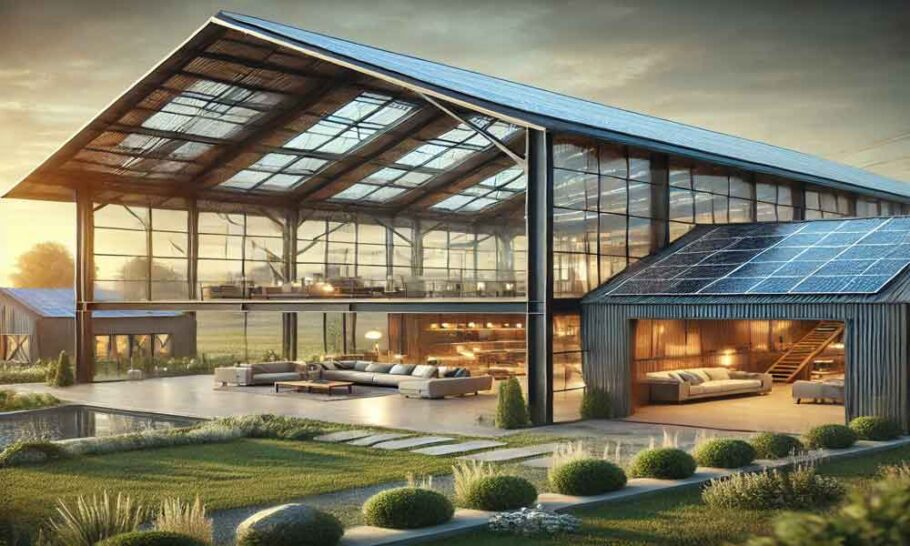When you think of barndominiums, the first things that often come to mind are open floor plans, cost efficiency, and modern-rustic aesthetics. But if you’re considering building one in an earthquake-prone area, another question arises: Can a metal-barndominium frame actually perform well when the ground starts shaking?
The short answer is yes—but only if it’s engineered and constructed correctly. Metal-frame barndominiums can be remarkably resilient to seismic forces, sometimes even outperforming traditional wood-frame houses. To understand why, let’s dive into the science of earthquakes, structural behavior, and how metal construction can be adapted for seismic safety.
Understanding Earthquake Forces
An earthquake is essentially the sudden release of stress along faults in the earth’s crust. This release sends waves of energy—P-waves, S-waves, and surface waves—radiating outward. For a building, these waves translate into:
- Lateral forces: Side-to-side shaking, which tends to cause the most structural damage.
- Vertical forces: Up-and-down movement, which stresses connections and load-bearing members.
- Torsional forces: Twisting effects, especially dangerous for asymmetrical floor plans.
The goal of any seismic-resistant building is not to completely eliminate damage (which is often impossible in a severe quake), but to prevent collapse and protect lives. That means the building must be able to absorb energy, deform without failure, and maintain load paths even during extreme shaking.
Why a Metal Frame Can Be an Advantage
Barndominiums typically use steel post-frame or rigid metal framing systems. In earthquake engineering, steel brings several inherent advantages over other building materials:
- Ductility (Flexibility Under Stress)
- Steel can bend, twist, and yield without snapping, unlike brittle materials such as unreinforced masonry.
- This ductility allows a metal barndominium to absorb seismic energy rather than resist it in a brittle manner.
- Strength-to-Weight Ratio
- Steel framing is strong yet lighter than concrete or masonry.
- A lighter building means less seismic force is generated during shaking, since seismic forces are proportional to building weight.
- Continuity of Load Path
- Properly designed metal frames create clear, direct load paths for seismic forces to travel down to the foundation.
- This reduces weak points and irregularities, which are often the cause of structural failure.
- Prefabrication and Precision
- Metal frames are often pre-engineered and fabricated in controlled shop conditions.
- Better precision means tighter connections and fewer unexpected weaknesses when the building is under stress.
The Role of Connections in Seismic Performance
In a metal-frame barndominium, the connections—bolts, welds, gusset plates, and brackets—are just as important as the beams and columns themselves. During an earthquake, most failures occur at joints, not in the middle of a beam.
To perform well in an earthquake zone, barndominium connections should be:
- Bolted, not just welded: Bolts allow for some slippage and ductility, while brittle welds may crack under stress if not engineered correctly.
- Redundant: Multiple fasteners per connection mean if one fails, others can still hold.
- Properly anchored to the foundation: The strongest frame is useless if it isn’t tied securely to the slab or pier system.
Foundation Considerations for Earthquake Zones
No frame—metal, wood, or concrete—can survive without the right foundation strategy. In seismic zones, the foundation must:
- Anchor the Metal Frame Securely
- Anchor bolts or embedded steel plates tie the columns and walls into the concrete foundation.
- Distribute Loads Evenly
- Wide footings or reinforced slabs help spread seismic forces across more soil.
- Avoid Differential Settlement
- Uneven soil compaction or liquefaction (when saturated soil behaves like liquid during a quake) can crack foundations and tilt buildings.
- A geotechnical report is critical before construction, especially in soft soil regions.
- Allow for Reinforcement
- Steel reinforcement bars (rebar) within the concrete slab can resist tension forces created during lateral shaking.
Design Features That Improve Earthquake Resistance
While steel framing offers natural advantages, a barndominium still requires smart design to truly thrive in an earthquake-prone area. Here are some engineering strategies:
- Symmetrical Floor Plans
- Buildings that are uniform in shape perform better because earthquake forces distribute evenly.
- L-shaped or T-shaped designs may suffer torsion unless additional reinforcement is added.
- Shear Walls or Braced Frames
- While steel columns resist vertical loads, lateral shaking requires bracing systems.
- Options include:
- Diagonal steel bracing
- Rigid steel moment frames
- Reinforced shear walls (metal panels or cross-bracing)
- Lighter Roof Systems
- Heavy roofing materials (like clay tiles) increase seismic loads.
- Lightweight metal roofs pair well with steel barndominiums, reducing overall mass.
- Redundancy in Load Paths
- Multiple vertical and horizontal load paths ensure the building remains stable even if one element is compromised.
- Energy Dissipation Systems
- Advanced designs may incorporate dampers, base isolators, or flexible joints that absorb seismic energy.
- While not common in residential barndominiums, these systems are an option for high-risk areas like California.
Comparing Metal vs. Wood Barndominiums in Earthquake Zones
Many people wonder if wood-framed barndominiums might perform better than steel because of wood’s flexibility. While both materials have their merits, here’s a breakdown:
- Wood Advantages:
- Naturally flexible and lightweight
- Easier to modify and repair after a quake
- More forgiving in terms of minor construction errors
- Steel Advantages:
- Higher strength-to-weight ratio
- Greater durability against fatigue from multiple quakes
- Non-combustible and resistant to pests and rot (important after quake-related damage)
Ultimately, both can be engineered for seismic safety. However, steel provides a higher level of predictability because of its uniform properties and precision in fabrication.
Building Codes and Engineering Requirements
Whether you’re building in California, Alaska, or any other earthquake-prone state, building codes dictate minimum seismic design standards.
- IBC (International Building Code): Sets seismic provisions based on geographic location, soil type, and building use.
- ASCE 7 (Minimum Design Loads for Buildings): Provides detailed guidelines on how to calculate seismic forces and design accordingly.
- Local Amendments: States like California have stricter rules under the California Building Code (CBC), which is adapted from IBC with added seismic requirements.
For barndominium builders, this means:
- A structural engineer must review the frame design for seismic performance.
- Pre-engineered metal building suppliers often provide structural calculations to demonstrate compliance.
- Inspections will verify that foundations, connections, and anchoring meet code standards.
Real-World Case Studies of Steel in Earthquake Zones
While barndominiums are relatively new to the housing market, steel structures have been tested in earthquakes around the world:
- Northridge Earthquake (California, 1994): Many modern steel-frame buildings survived without collapse, though connection failures in welded joints highlighted the importance of bolted connections.
- Tohoku Earthquake (Japan, 2011): Steel-framed industrial and commercial buildings often fared better than older concrete and masonry buildings.
- Chile Earthquake (2010): Light steel framing in residential structures showed strong resilience compared to heavier traditional systems.
These lessons apply directly to metal barndominiums: with the right engineering, steel can save lives.
The Bottom Line: Yes, Metal Barndominiums Can Perform Well
So, can a metal-barndominium frame perform well in an earthquake zone? Absolutely—if designed with seismic engineering principles in mind.
The keys are:
- Using steel’s ductility and strength to your advantage
- Prioritizing connections and anchorage
- Incorporating bracing and redundancy into the design
- Building on a properly engineered foundation
- Following seismic codes and working with licensed engineers
A well-designed metal barndominium won’t just survive an earthquake—it can keep your family safe and minimize repair costs after the shaking stops.
Final Thoughts
If you’re planning to build a barndominium in California, Oregon, Alaska, or any region with seismic risk, don’t cut corners on engineering. Metal frames offer significant benefits, but performance depends on how well the system is designed, fabricated, and built.
Think of it this way: your barndominium isn’t just a home—it’s a shelter. By investing in proper seismic design, you’re not only protecting your property but also ensuring that your family has a safe place to ride out nature’s most unpredictable forces.

